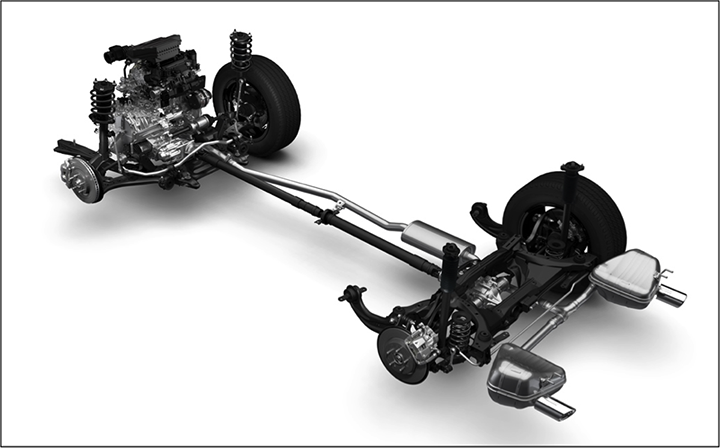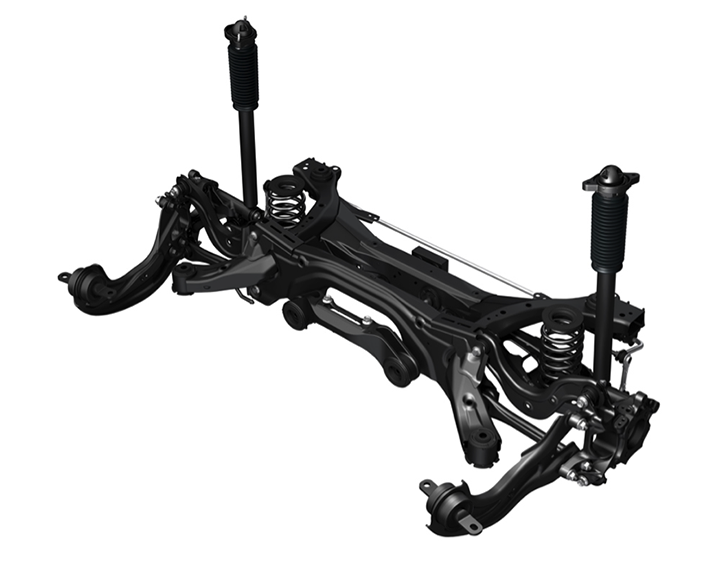The new 2017 Honda CR-V chassis has evolved to provide more agile and confident handling, additional ground clearance, and improved overall versatility. Increased front and rear track widths combined with front MacPherson strut and rear multi-link suspension with specially tuned low-friction dampers and tubular front and solid rear stabilizer bars promote more responsive turn-in and flatter cornering. A new dual-pinion, variable gear ratio Electric Power Steering (EPS) system also contributes to the CR-V’s direct steering feel.
All trims include fluid-filled suspension bushings for improved ride quality and isolation from road noise, vibration and harshness (NVH). Vehicle Stability Assist™ (VSA®) with Traction Control and a 4-channel Anti-Lock Braking System (ABS) with Brake Assist, and a new electric brake booster (EBB) add to the CR-V’s features. Straight Driving Assist reduces steering effort when driving on sloped or crowned roads, while Agile Handling Assist uses the brakes to improve both turning response and cornering ability. An Electric Parking Brake (EPB), Automatic Brake Hold and Hill Start Assist add convenience in traffic or on hills.
Front and Rear Suspension of the Honda CR-V
The 2017 Honda CR-V’s wider track, longer wheelbase and new suspension are the consequence of a combination of front MacPherson struts and rear multi-link with floating subframes and fluid-filled compliance bushings, and features specially tuned dampers with larger bodies and low-friction bushings that enhance the car’s sporty character.
Using a strut-style front suspension improves the room available for crash reinforcement. Meanwhile the compact multi-link rear suspension provides a combination of ride quality and handling while also helping to maximize second-row seating and cargo space. Front and rear stabilizer bars on all trims improve turn-in response while reducing body roll during cornering. The stabilizer bars are bonded to their mounting bushings and use low-friction connecting links.
MacPherson Strut Front Suspension
The MacPherson strut front suspension is engineered to provide better handling performance and a responsive feel for the driver. The lower suspension arms are connected to the subframe and to the body via fluid-filled compliance bushings (described below), providing a compromise of handling responsiveness and precision, along with maximum isolation from road noise, vibration and harshness (NVH). All front suspension arms and the front hub carriers are steel, and all CR-V models and trims use a tubular front stabilizer bar.
Multi-Link Rear Suspension
The new multi-link rear suspension includes stamped-steel arms, cast-aluminum hub carriers and a solid stabilizer bar. Mounted on a new floating (rubber-mounted) subframe for noise reduction, the rear suspension supposedly provides agile handling, both during normal driving and in emergency maneuvers, together with a flat ride. The trailing arms are located on the unibody with fluid-filled compliance bushings (described below) for control of noise, vibration and harshness (NVH) while maintaining handling. All Honda CR-V use a solid rear stabilizer bar.
Fluid-Filled Suspension Compliance Bushings
The CR-V’s suspension uses front and rear fluid-filled compliance bushings to provide improved ride isolation as well as chassis vibration control. These bushings are specifically tuned to provide minimum vibration transfer to the occupants, reducing the overall noise, vibration and harshness (NVH).
In front, the lower control arms pivot in the fluid-filled bushing, while in back, the leading edge of the suspension’s trailing arms pivot in the bushing.
Dual Pinion Variable Ratio Electric Power-Assisted Rack-and-Pinion Steering (EPS)
The Electric Power Steering (EPS) incorporates dual pinion gears and a variable gear ratio (VGR) for enhanced low-speed maneuverability and high-speed stability. Compared to a traditional single-pinion steering system, the dual pinion EPS utilizes the physical steering input from the driver as well as from a supplemental electric motor. A non-contact torque sensor measures the driver’s steering effort and an ECU determines how much electric motor assist to add, with the result claimed to be a seamless, natural-feeling steering in all situations.
The steering ratio is variable over a 20-percent range with a final full off-center ratio of 12.3:1. This provides a 2.3 turns lock-to-lock – significantly quicker than the 2016 CR-V’s 3.1 turns – enabling easier low-speed maneuvering and parking. The variable ratio allows for slower gearing around the straight-ahead position for improved stability at high speeds. Also contributing to the enhanced steering performance and feel of the CR-V are reduced operating friction, a high level of stiffness for the steering mount, and a larger diameter, more rigid steering column shaft (8 mm larger than the 2016 CR-V).
Source: Honda




















